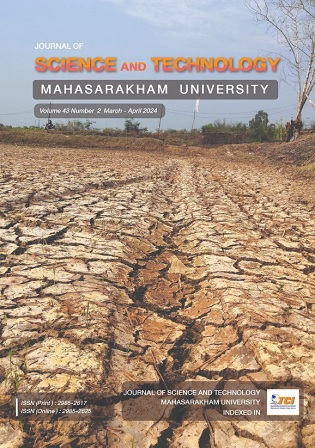Numerical simulation of heat transfer and fluid flow of nanofluid jet impingement on straight fn heat sink
Main Article Content
Abstract
The article presents a numerical investigation on heat transfer and fluid flow of the nanofluid jet impingement on an isothermal pin-fin heat sink surface using the single-phase model. The finite volume method was used for the solution of resulting governing equations. Al2O3 nanoparticles dispersed in water with the volumetric concentration of nanoparticles ranging between 0 and 4% were used as working fluid for simulating the heat transfer and fluid flow. The influences of the volumetric concentration of nanoparticles and Reynold number were examined and discussed in details. The results indicated that the volumetric concentration of nanoparticles and Reynold number enhance heat transfer where considering in terms of the stagnation, the local and the average Nusselt number. Moreover, two types of nanofluid as Al2O3-water nanofluid and TiO2-water nanofluid were compared. The Al2O3-water nanofluid enhanced heat transfer less than the TiO2-water nanofluid.
Article Details
References
Abdelrehim, O., Khater, A., Mohamad, A.A. & Radwan, A. (2019). Two-phase simulation of nanofluid in a confined single impinging jet. Case Studies in Thermal Engineering,14, 100423.
Alkasmoul, F.S., Al-Asadi, M.T., Myers, T.G., Thompson, H.M. & Wilson, M.C.T. (2018). A practical evaluation of the performance of Al2O3-water, TiO2-water and CuO-water nanofluids for convective cooling. International Journal of Heat and Mass Transfer, 126, 639–651.
Chaiyo, K. (2021). Numerical simulation of heat transfer and fluid flow in a confined jet impingement using water-TiO2 nanofluid. Journal of Science and Technology Mahasarakham University, 40(4), 373-383.
Choi, S.U.S. & Eastman, J.A. (1995). Enhancing thermal conductivity of fluids with nanoparticles. ASME International Mechanical Engineering Congress & Exposition, 66, 99–105.
Ferrari, J., Lior, N. & Slycke, J. (2003). An evaluation of gas quenching of steel rings by multiple-jet impingement. Journal of materials processing technology, 136, 190–201.
He, Y., Men, Y., Zhao, Y., Lu, H., & Ding Y. (2009). Numerical investigation into the convective heat transfer of TiO2 nanofluids flowing through a straight tube under the laminar flow conditions. Applied Thermal Engineering, 29, 1965-1972.
Ho, C.J., Liu, W.K., Chang, Y.S., & Lin, C.C. (2010). Natural convection heat transfer of alumina-water nanofluid in vertical square enclosures: an experimental study. International Journal of Thermal Sciences, 49, 1345-1353.
Jeng, T.M., Tzeng, S.C., Tseng, C.W., & Li, Y.C. (2021). Effect of transverse synthetic jet on heat transfer characteristics of the heat sink situated in a rectangular channel with axial main flow. Heat and Mass Transfer, 57, 1145–1159.
Manca, O., Ricci, D., Nardini, S., Di Lorenzo & G. (2016). Thermal and fluid dynamic behaviors of confined laminar impinging slot jets with nanofluids. International Communications in Heat and Mass Transfer, 70, 15–26.
Mookherjee, O., Pramanik, S. & Kumar Kar, U. (2020). Numerical investigation of a confined laminar jet impingement cooling of heat sources using nanofluids. ASME Journal of Heat Transfer, 142 (8), 082301.
Lu, X., Li, W., Li, X., Ren, J. Jiang, H., & Ligrani, P. (2019). Flow and heat transfer characteristics of micro pin-fins under jet impingement arrays. International Journal of Heat and Mass Transfer, 143, 118416.
Oztop, H.F., & Abu-Nada, E. (2008). Numerical study of natural convection in partially heated rectangular enclosures filled with nanofluids. International Journal of Heat and Fluid Flow, 29 1326–1336.
Patankar, S.V. (1980). Numerical heat transfer and fluid flow. Hemisphere Publishing.
Rao, Y. (2018). Jet impingement heat transfer in narrow channels with different pin fin configurations on target surfaces. ASME Journal of Heat Transfer, 140 (2), 072201.
Rohsenow, W.M., Hartnett, J.P. & Cho, Y.I. (1998). Handbook of heat transfer (3rd edition). McGraw-Hill.
Sajadi, A.R., & Kazemi, M.H. (2011). Investigation of turbulent convective heat transfer and pressure drop of TiO2/water nanofluid in circular tube. International Communications in Heat and Mass Transfer, 38, 1474–1478.
Selvakumar, P. & Suresh, S. (2012). Convective performance of CuO/water nanofluid in an electronic heat sink. Experimental Thermal and Fluid Science, 40, 57–63.
Venkitaraj, K.P, Suresh, S., Alwin M., T, Bibin, B.S & Abraham, J. (2018). An experimental investigation on heat transfer enhancement in the laminar flow of water/TiO2 nanofluid through a tube heat exchanger fitted with modified butterfly inserts. Heat and Mass Transfer, 54, 813–829.
Zhao, J., Huang, S., Gong, L., & Huang, Z. (2016). Numerical study and optimizing on micro square pin-fin heat sink for electronic cooling. Applied Thermal Engineering, 93, 1347–135.
Zuckerman, N. & Lior, N. (2006). Jet impingement heat transfer: physics, correlations, and numerical modeling. Advances in Heat Transfer, 39, 565–631.


